In this article:
Prolonged exposure to the harsh sun can damage your skin, causing tanning, premature aging, and even sunburn. The UV rays coming from the sun are strong enough to stimulate a defense reaction in the skin within 10 minutes of exposure.
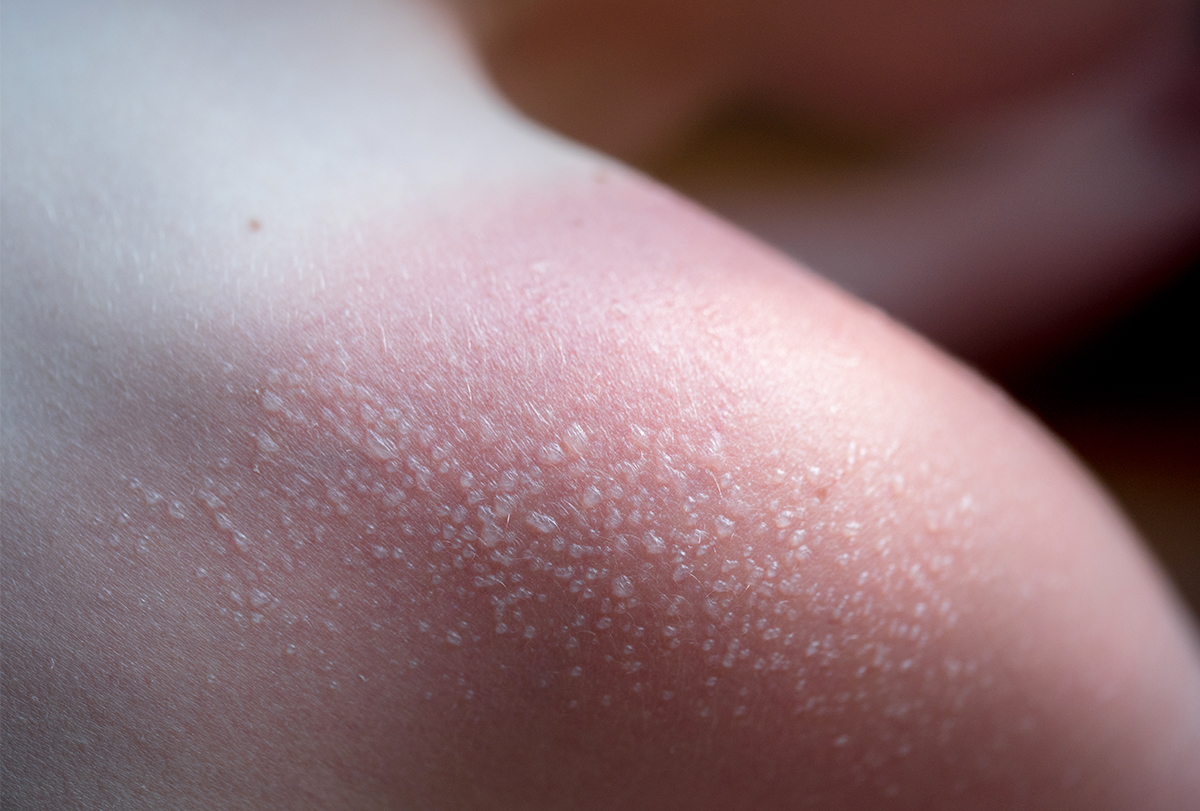
These UV rays are of three types, namely, UVA, UVB, and UVC, which differ in their wavelengths. UVC radiation is the most damaging, but it is almost completely absorbed by the atmosphere before sunlight hits the ground.
However, UVA and UVB radiations can inflict damage on your skin in different ways:
- UVA – These UV rays can penetrate deep into the skin and inhibit new skin cell generation. This causes premature skin aging, damages the eye, and also weakens the immune system. (1) Exposure to UVA rays can also increase the risk of skin cancer and can commonly cause sunburn.
- UVB – These UV rays are stronger than UVA rays (1) and can damage the cellular DNA, contributing to an increased risk of skin cancer. UVB rays are largely responsible for sunburns.
What Are Sunburn Blisters?
As mentioned above, when your skin is exposed to intense sunlight, it may get burned due to the harsh UV radiation. The damage is characterized by swelling, redness, warmth, and pain.
However, in severe cases, your skin may develop inflamed blisters, which can disconnect skin cells from each other. This leads to breaks in the skin, causing drainage of fluid into the blisters. (2)
The blisters may develop up to 24 hours after a sunburn and are characterized by small, white fluid-filled bumps over a large area of the skin. These blisters are surrounded by swollen, red skin.
The blisters can be painful, tender, and itchy and increase the risk of infection. While a sunburn only affects the epidermis, or the outer skin layer, blister formation is a second-degree burn that affects the inner dermis skin layers as well. (3)
Managing Sunburn Blisters
Sunburn blisters develop due to prolonged exposure to the sun and are often accompanied by various complications, including vomiting, nausea, chills, fever, dehydration, infection, delayed healing, post-inflammatory hyperpigmentation, and scarring.
Therefore, it is best to seek immediate medical treatment for severe blistered sunburn. The doctor may apply dressing to the affected area and prescribe burn creams that help soothe your skin and aid healing.
Along with medical treatment, you can also take self-care measures to facilitate the healing process and prevent the blisters from exasperating.
You may follow the following tips upon consulting your doctor:
1. Apply a cold compress
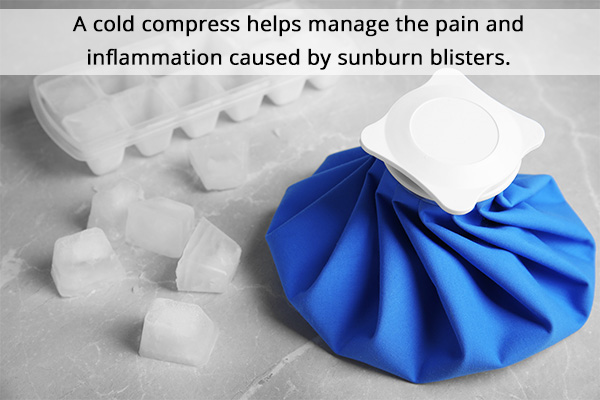
Applying a cold compress can relieve your skin from the heat associated with a sunburn. This remedy also helps manage the pain and inflammation caused by sunburn blisters. (4)
You can use an ice pack or a cool, wet towel and place it on the affected area for about 10–15 minutes. Always wrap the ice or ice pack in a towel before application, and refrain from leaving it on the skin for long periods.
2. Take a cold bath
Fill your bath with cool water and soak yourself in it. This soothes the skin and relieves pain and stinging sensation to some extent.
3. Refrain from picking at the blisters
It is a common habit to pop blisters on the skin. However, picking at these fluid-filled pockets can do more harm than good. Popping blisters can interfere with skin healing and also increase the risk of infections. It is best to leave the blisters alone and allow them to dry up or drain on their own.
4. Do not peel the burnt skin
In case you accidentally pop your blister, avoid peeling off the dead skin as it can result in infection and scarring. If your skin becomes scarred, consult your doctor for scar treatments.
5. Apply a steroid cream
You can use topical steroids such as a 1% hydrocortisone cream to control the inflammation and itching.
6. Take OTC pain meds if required
Aside from topical medications, you can take oral drugs such as nonsteroidal anti-inflammatory drugs (NSAIDs) (ibuprofen or aspirin) to relieve the inflammation, pain, swelling, and redness.
7. Moisturize the skin
It is essential to moisturize your sunburnt skin to help it heal quicker. It is best to use lotions containing aloe vera or calamine.
Make sure to avoid any creams that contain benzocaine or lidocaine as they can irritate the skin. Similarly, avoid petroleum-based products as they can trap in the heat.
8. Use after-sun lotions
After-sun lotions are highly useful in case you forget to apply your sunscreen before stepping outdoors. These lotions contain hydrating agents such as lipids, ceramides, glycerin, and hyaluronic acid that help moisturize your skin, strengthening its barrier function.
In addition, after-sun lotions are rich in antioxidants that fight against the free radicals generated after sun exposure.
It is suggested to use creams that contain papaya, aloe vera, cucumber, and chamomile as they are soothing and moisturizing. Avoid heavy ointments or occlusive as they trap the heat and prevent your skin from cooling down.
9. Apply aloe vera gel on the blisters
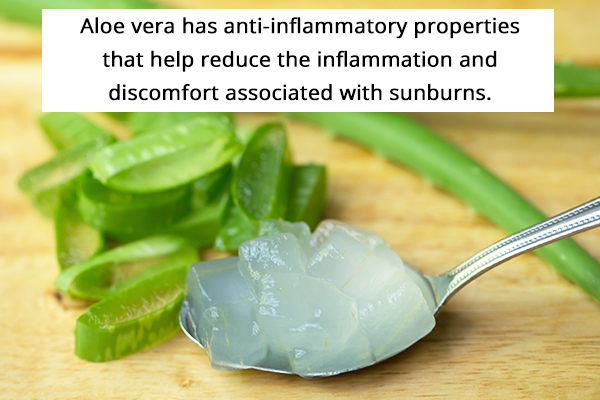
Aloe vera is known for its burn-healing properties and can therefore be helpful in the treatment of sunburn blisters. Its anti-inflammatory properties help reduce the inflammation and discomfort associated with sunburns. (5)
In addition, aloe vera gel can soothe the skin, provide nutrition and moisture, and also boost collagen production. However, make sure to use aloe vera gel only if your blisters are intact, as open wounds may be susceptible to irritation and infection.
10. Avoid friction and chemicals
Make sure to protect the affected area from irritant chemicals or harsh surfaces that can pop the blister. Use only a soft washcloth to pat the area dry instead of rubbing it. Also, avoid using harsh exfoliators and cleansers that are chemical laden.
11. Wear loose clothing
Wear only loose pants and shirts that do not stick to your skin to avoid pain and popping of your blisters. Using tight clothing can put undue pressure on the skin and increase pain.
12. Prevent sun exposure
While your skin is healing from the sunburn blisters, it is vital that you protect it from further sun exposure. If you do need to go outside, make sure to cover the affected area with loose clothing. Use sunscreens after the blisters have healed.
13. Consume plenty of water
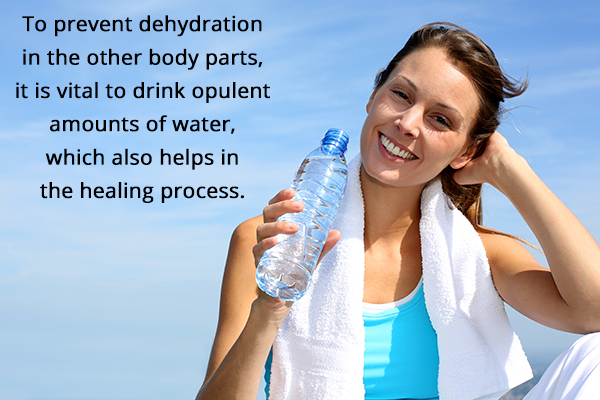
Your body increases water supply to the sunburnt areas for proper healing. To prevent dehydration in the other body parts, it is vital to drink opulent amounts of water, which also helps in the healing process.
14. Eat superfoods
Sun exposure generates free radicals in the skin, which are responsible for DNA and skin cell damage. Consuming fruits, vegetables, and superfoods rich in antioxidants and phytochemicals can help combat these free radicals and minimize damage.
It is recommended to eat blackberries, strawberries, blueberries, prunes, plums, artichokes, pecans, and beans. (6)
Preventive Tips to Avoid Sunburn
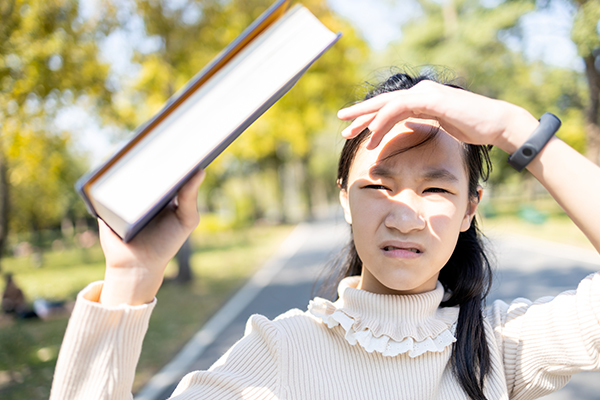
It is fairly easy to avoid sunburn and therefore sunburn blisters. The following tips may be helpful:
- Avoid staying under the sun for long periods, especially between 10 am and 4 pm when the UV radiation is at its strongest.
- Seek shade whenever possible, and wear protective clothing such as long-sleeved shirts, full-length pants, wide-brimmed hats, and sunglasses.
- Use sunscreen daily, even if it is cloudy and the sun rays are not very evident as UV rays will still be emitted.
- Apply a water-resistant sunscreen with SPF 30 or higher at least 15 minutes before stepping out.
- Reapply your sunscreen every 2 hours under the sun or after swimming, taking a bath, or excessive sweating.
When to See a Doctor
Sunburn blisters, being a second-degree burn, require medical care, especially if you experience extreme pain, excessive redness, and blisters that do not improve with the treatment options mentioned above.
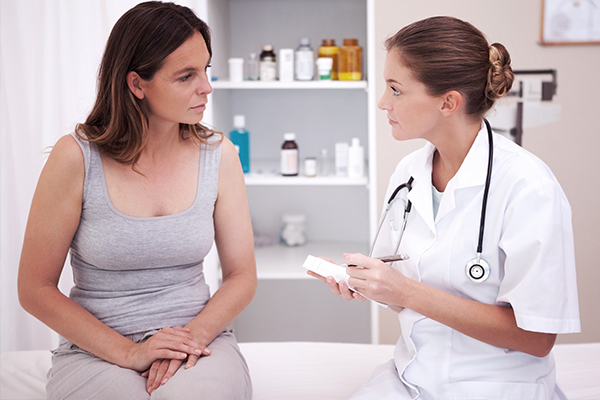
Make sure to consult a doctor if:
- The blisters affect a large area of the body.
- You have fever or chills.
- You feel dizzy, weak, or nauseous.
- The blisters ooze pus or red streaks.
- You experience extreme pain.
Final Word
Sunburns can heal on their own, but they can often damage your skin from within. Moreover, sunburn blisters can be highly painful and discomforting, also increasing the risk of skin cancer every time.
Therefore, it is essential to protect your skin from excessive sun exposure. If you do develop a sunburn blister, make sure to treat it with care until it heals. Contact your doctor if the affected area is large or extremely painful.
- Was this article helpful?
- YES, THANKS!NOT REALLY


